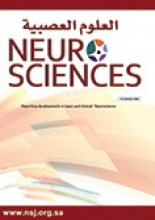Abstract
OBJECTIVE: The study was conducted as part of an overall evaluation for an outreach program to evaluate the clinical status of all the participating children, identify management problems, if any, and offer relevant recommendations.
METHODS: All the participating children were subjected to a detailed clinical evaluation using a structured questionnaire developed for the purpose. The subjects of this study were registered in the Center for Disabled Children in Buraidah and Unaizah, Al-Qassim region, Kingdom of Saudi Arabia. This study was conducted in 1998 to include all registered children in the centers, which were established in 1994.
RESULTS: One hundred and eleven children were evaluated, 51.8% were males. Average age was 72.31 months (standard deviation 32.99). The children fell into 3 diagnostic groups: Cerebral palsy (CP) group (n=41), chromosomal abnormalities group (n=36) and miscellaneous group (n=34). Mothers were the direct care-givers in 98.1% of cases. The sample as a whole suffered from a number of disabilities, the most common of which was severe speech difficulty (88.3%). Fifty seven percent of the children were severely malnourished. The CP group suffered most, as they were significantly fewer mobiles and more dependants on the care-giver. History of neonatal asphyxia and severe malnutrition at the time of examination were also significantly more common in this group.
CONCLUSION: This group of disabled children is enjoying a comprehensive rehabilitation service delivered through an efficient outreach program. It was observed that the families need extra support to improve mobility, nutrition and communication abilities of the participating children.
- Copyright: © Neurosciences
Neurosciences is an Open Access journal and articles published are distributed under the terms of the Creative Commons Attribution-NonCommercial License (CC BY-NC). Readers may copy, distribute, and display the work for non-commercial purposes with the proper citation of the original work.






